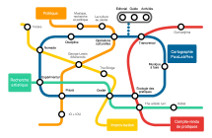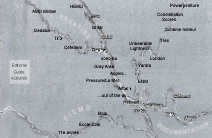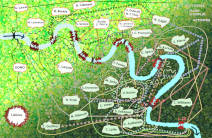On this page:
GUIDE “Break down the Walls” (2021)
Guide “PaaLabRes’ Map” (2016)
 |
This Edition is presented in the form of a subway train map, with a central circular line and four other lines. Each line represents an important aspect of the collective PaaLabRes’ concerns: PaaLabRes Cartography (central line), Political , Improvisation , Artistic Research and Projects and Actions . Here are the directions for use of the map: |
The 2016 Edition is composed of 18 texts (sometimes recorded spoken words, sometimes videos of animated texts). One can access them by clicking on each of the 18 metro stations.
The 2016 Edition is also composed of 72 extracts of artistic objects (audio recordings, videos, images, animated texts) realized by 36 artists. These artistic objects, we call them “Itineraries-Songs” can be found in between the stations of the central line PaaLabRes Cartograpy . To access them you have to click on one of the stations of the central line and read (or not) the text. On the right side of the text (or underneath the text), there is a map of the central line in blue. To access an Itinerary-Song you have to click on any one of the stations of the central line placed on this map. An Itinerary-Song will lead you nicely towards the selected station. Credits appear at the end of the Itinerary-Song with the title and the names of the artists. There are 9 stations on this central line, which results in 72 possibilities of connection between stations.
See the list of the Itineraries-Songs and the list of this Edition’s contributors.
Go to the “PaaLabRes’ Map” EDITORIAL (2016)
Guide “Graphic Scores” (2017)
 |
This new edition is presented in the form of a roadmap, reminiscent of the metro map of our first formal proposition (2016 Edition), taking as basis a photograph of a painting by Lyon artist Christian Lhopital (we thank him for his generous contribution). We took advantage of the presence of seismic “faults” on this painting to use them as lines for connections between what we call “known places” [“lieux-dits”] in a meaningful way. Some contributions are grouped together on the map in regions (Treatise, films, documentation). |
The map consists of two big categories:
![]()
- An artistic performance (audio or video) of a graphic score, which can be triggered by clicking on the “known place”, that is the name of the contribution. An explicative, theoretical or poetical text appears when one goes from one “known place” to either of the two neighboring “known places”, in the form of a collage with the text of the neighboring contribution.
- Performances of Cardew’s Treatise, which are clustered in one part of the map and are presented in the same format.
- Three musical illustrations of films.
![]()
These are reference articles, interviews or documentation pertaining to the question of graphic scores.
You can move freely in the new map by clicking on any of the names of the known places. But the spirit of our approach is definitively on the side of taking a path following the lines, or seismic “faults” (as in “San Andreas fault”): the strolling from one known place to its neighbor reveals a collage of texts or spoken words provided by the contributors. We strongly encourage you to follow a pathway along on a fault line.
Go to the “Graphic Scores” EDITORIAL (2017)
Guide “Break Down the Walls” (2021)
The home page can be seen in light or dark green. It works as follows:
 |
|
- The Houses are represented by 27 bubbles. Inside each bubble is the name of a contributor (or contributors) to the edition. Each house contains the complete contribution corresponding to the displayed name (or names).
- Pathways that lead from the houses to the river. They indicate the places in the Grand Collage where extracts from the corresponding contributions are included. The pathways lead to where one of the 26 sequences starts in the Grand Collage.
It is possible to:
- Click on the river in the space corresponding to one of the 26 sequences. The corresponding sequence will be played from the start and at the end of the sequence an arrow will allow to continue to the next. The Grand Collage can be stopped at any time by clicking on a house (small bubble) on the right side of the screen, or on the miniature map representing the 2021 edition home page.
- During the course of the Grand Collage, the name of a contributor will appear in a bubble (house) on the right side of the screen, when an extract will be played corresponding to this name. By clicking on a name, you will be able to access the full contribution corresponding to that name. By clicking on the miniature map you will be able to return to the home page of the edition.
- Click on a house on the map will give access to the full contribution corresponding to the name. When passing the curser on the house, a bubble will appear describing the content of the contribution. The contributions always appear in their original language (English or French). At the top of the article a link (or sometimes several links) allows access to the translation in the other language.
Go to the “Break down the Walls” EDITORIAL (2021)